Research on Optimization of Orebody Mining Sequence Under Isolation Layer of Filling Body Based on FLAC3D Software
Abstract
1. Introduction
2. Research Method
2.1. Geological Overview and Study Area
2.2. Numerical Simulation Method
2.2.1. Model Construction
2.2.2. Constitutive Model Selection
2.2.3. Material Parameter Selection
2.2.4. Numeric Simulation Scheme
3. Numerical Simulation Analysis
3.1. Optimization Analysis of Pillar Mining Sequence
3.1.1. Compressive Stress Distribution
3.1.2. Tensile Stress Distribution
3.1.3. Displacement Response
3.2. Optimization Analysis of Stope Mining Sequence
3.2.1. Compressive Stress Distribution
3.2.2. Tensile Stress Distribution
3.2.3. Displacement Response
3.3. Determination of Optimal Mining Sequence
4. Conclusions
Author Contributions
Funding
Data Availability Statement
Conflicts of Interest
References
- Zhou, K.; Zhang, C.; Shuai, J.; He, W.; Ren, G.; Cheng, R. Optimization Study of Mining Scheme for the Residual Ore Body under the Complex Back-Fill. Met. Mine 2017, 12, 14–20. [Google Scholar]
- Dintwe, T.K.M.; Sasaoka, T.; Shimada, H.; Hamanaka, A.; Moses, D. Evaluating the Influence of Underground Mining Sequence under an Open Pit Mine. J. Min. Sci. 2022, 58, 35–43. [Google Scholar] [CrossRef]
- Eremenko, A.A.; Klishin, V.I.; Eremenko, V.A.; Filatov, A.P. Feasibility study of a geotechnology for underground mining at Udachnaya kimberlite pipe under the opencast bottom. J. Min. Sci. 2008, 44, 271–282. [Google Scholar] [CrossRef]
- Zhang, Y.; Huang, Q.; Yan, M. Development and Problems of Mining Similar Simulation Experiment Technique. Coal Technol. 2008, 1, 1–3. [Google Scholar]
- Qi, W.; Zhu, Q.; Zhao, X.; Li, W. Numerical simulation of stability control of fractured rock mass in southwest wing of Xinli Mining area, Sanshandao Gold Mine. Nonferrous Met. 2019, 71, 88–94. [Google Scholar]
- Deng, H.; Yang, Y.; Deng, J.; Liu, C.; Zhao, Y. Study on Mining Sequence of Deep Orebody Under High Stress Environment Below Goaf. Gold Sci. Technol. 2017, 25, 62–69. [Google Scholar]
- Gao, F.; Zhou, K.-P.; Dong, W.-J.; Su, J.-H. Similar material simulation of time series system for induced caving of roof in continuous mining under backfill. J. Cent. South Univ. Technol. 2008, 15, 356–360. [Google Scholar] [CrossRef]
- Ye, Y.; Shi, Y.; Wang, Q.; Liu, Y.; Yao, N.; Lu, F. Experimental study of deformation of wall rock and stoping sequence in mining gently inclined and multilayer deposits by backfill mining. J. Min. Saf. Eng. 2015, 32, 407–413. [Google Scholar]
- Cui, F.; Jia, C.; Lai, X. Study on Deformation and Energy Release Characteristics of Overlying Strata under Different Mining Sequence in Close Coal Seam Group Based on Similar Material Simulation. Energies 2019, 12, 4485. [Google Scholar] [CrossRef]
- Moosavi, E.; Gholamnejad, J. Optimal extraction sequence modeling for open pit mining operation considering the dynamic cutoff grade. J. Min. Sci. 2016, 52, 956–964. [Google Scholar] [CrossRef]
- Zhou, K.; Gu, D. Optimization of stoping sequence in underground mine by using genetic algorithm method. China Min. 2001, 5, 52–56. [Google Scholar]
- Sears, M.M.; Slaker, B.; Rashed, G.; Miller, J. Analysis of the Impacts of Mining Sequence and Overburden Depth on Stability at a Dipping Limestone Mine. Min. Met. Explor. 2021, 38, 959–965. [Google Scholar] [CrossRef]
- Jiang, N.; Wang, C.; Pan, H.; Yin, D.; Ma, J. Modeling study on the influence of the strip filling mining sequence on mining-induced failure. Energy Sci. Eng. 2020, 8, 2239–2255. [Google Scholar] [CrossRef]
- Wang, P.; Li, H.; Li, Y.; Cheng, B. Stability analysis of backfilling in subsiding area and optimization of the stoping sequence. J. Rock Mech. Geotech. Eng. 2013, 5, 478–485. [Google Scholar] [CrossRef]
- GB 50771-2012; Code for Design of Nonferrous Metal Mining. Ministry of Housing and Urban-Rural Development of the People’s Republic of China: Beijing, China, 2012.
- Chen, Y.; Lin, H. Consistency analysis of Hoek–Brown and equivalent Mohr–coulomb parameters in calculating slope safety factor. Bull. Eng. Geol. Environ. 2019, 78, 4349–4361. [Google Scholar] [CrossRef]
- Maciej, B.; Jan, G.; Krzysztof, W. Numerical Simulation of Dry Ice Compaction Process: Comparison of the Mohr–Coulomb Model with the Experimental Results. Materials 2022, 15, 7932. [Google Scholar] [CrossRef] [PubMed]
- Banda, S.U. Geotechnical Approach for Slope Design and Management Strategy for Nchanga Open Pit, Zambia. Earth Sci. Front. 2009, 16, 241. [Google Scholar]
- Stacey, T.R. Slope stability in high stress and hard rock conditions. In Proceedings of the 2007 International Symposium on Rock Slope Stability in Open Pit Mining and Civil Engineering: Australian Centre for Geomechanics, Perth, Australia, 12–14 September 2007; pp. 187–200. [Google Scholar]
- Deng, K.; Chen, M.; Yan, P.; Leng, Z.; Yang, G. Analysis of Toe Formation in Stress-Concentration Zones on High Rock Slopes. KSCE J. Civ. Eng. 2022, 26, 966–976. [Google Scholar] [CrossRef]
- Tao, M.; Luo, F. Analysis of Pillar Stability and Optimization of Mining Sequence in Ningdu Pyrite. Min. Technol. 2016, 16, 25–29. [Google Scholar]
- Cao, Y.; Liu, Y.; Deng, H. Optimization and Application of Stope Mining Sequence in Deep Orebody of Xiadian Gold Mine. Min. Res. Dev. 2021, 41, 1–7. [Google Scholar]

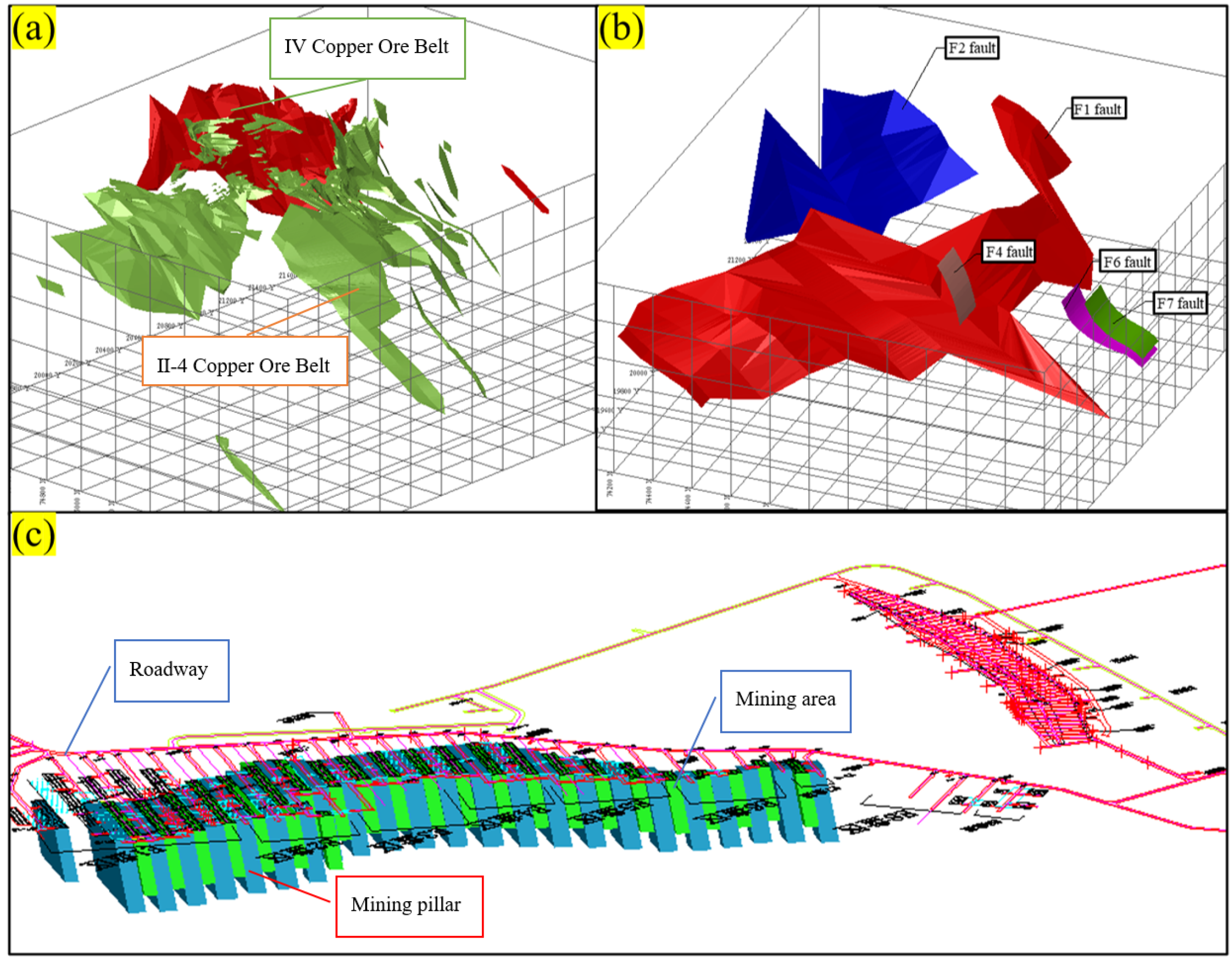


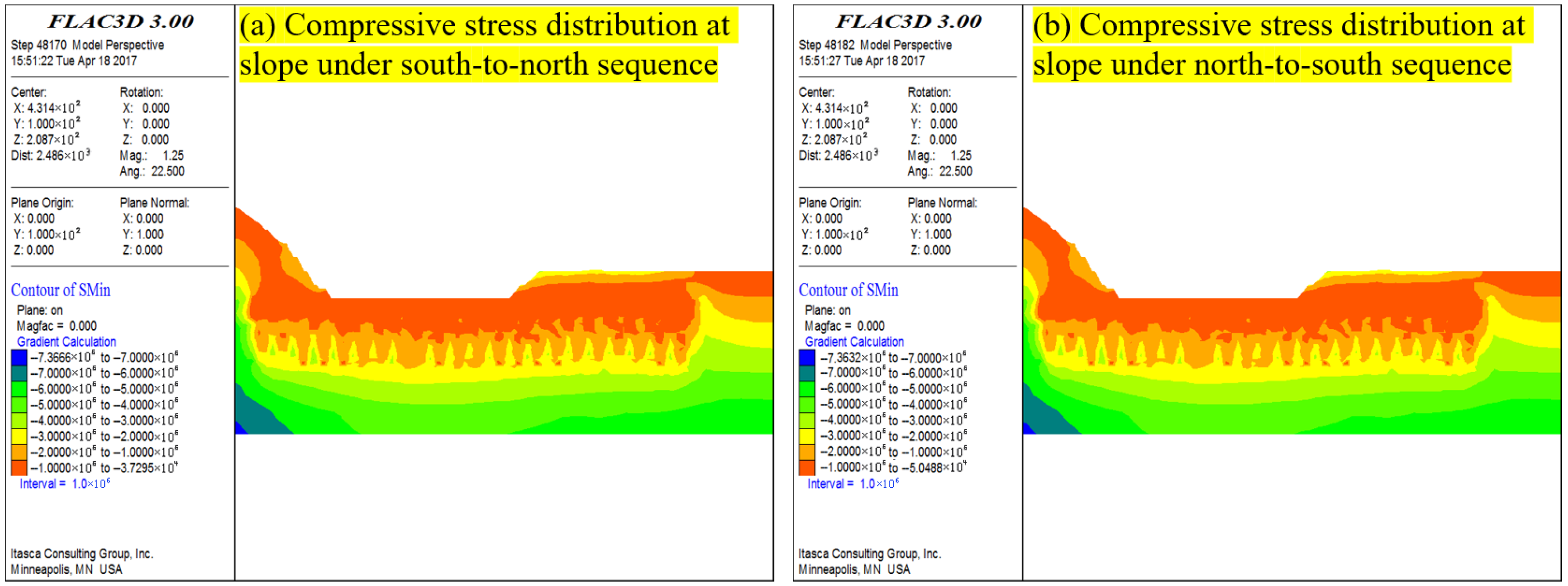
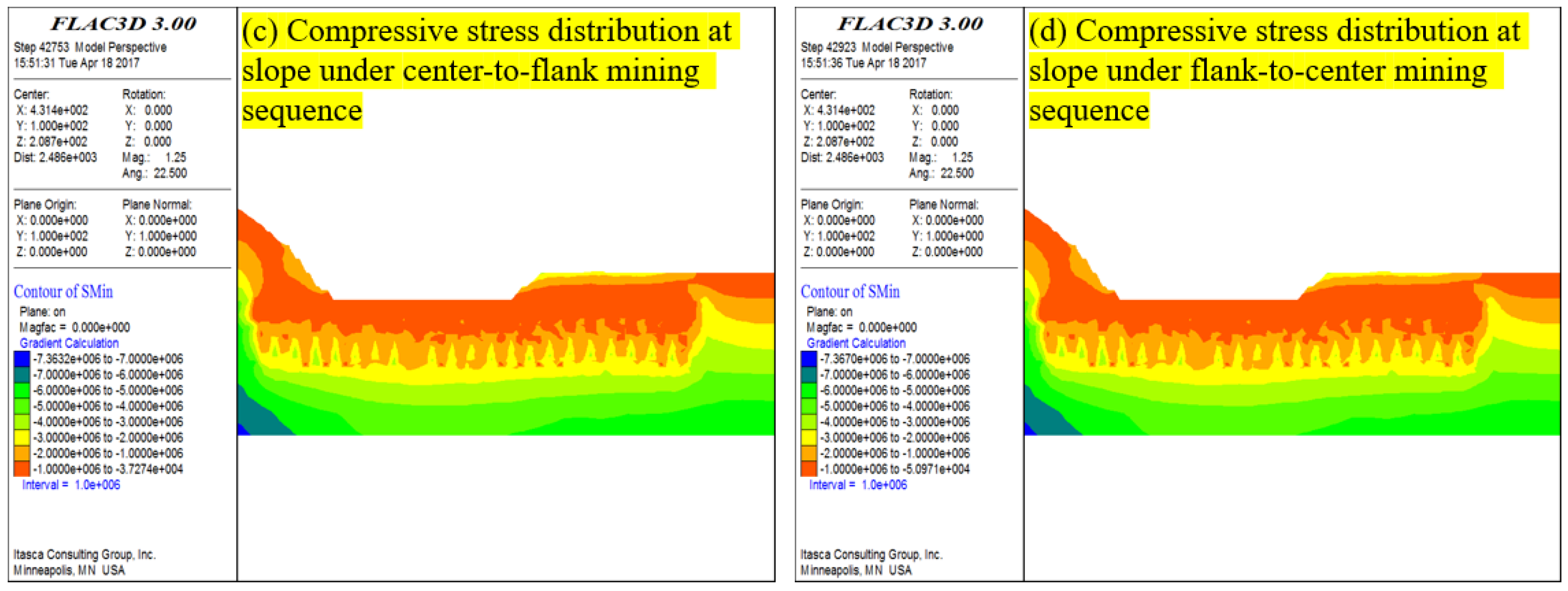

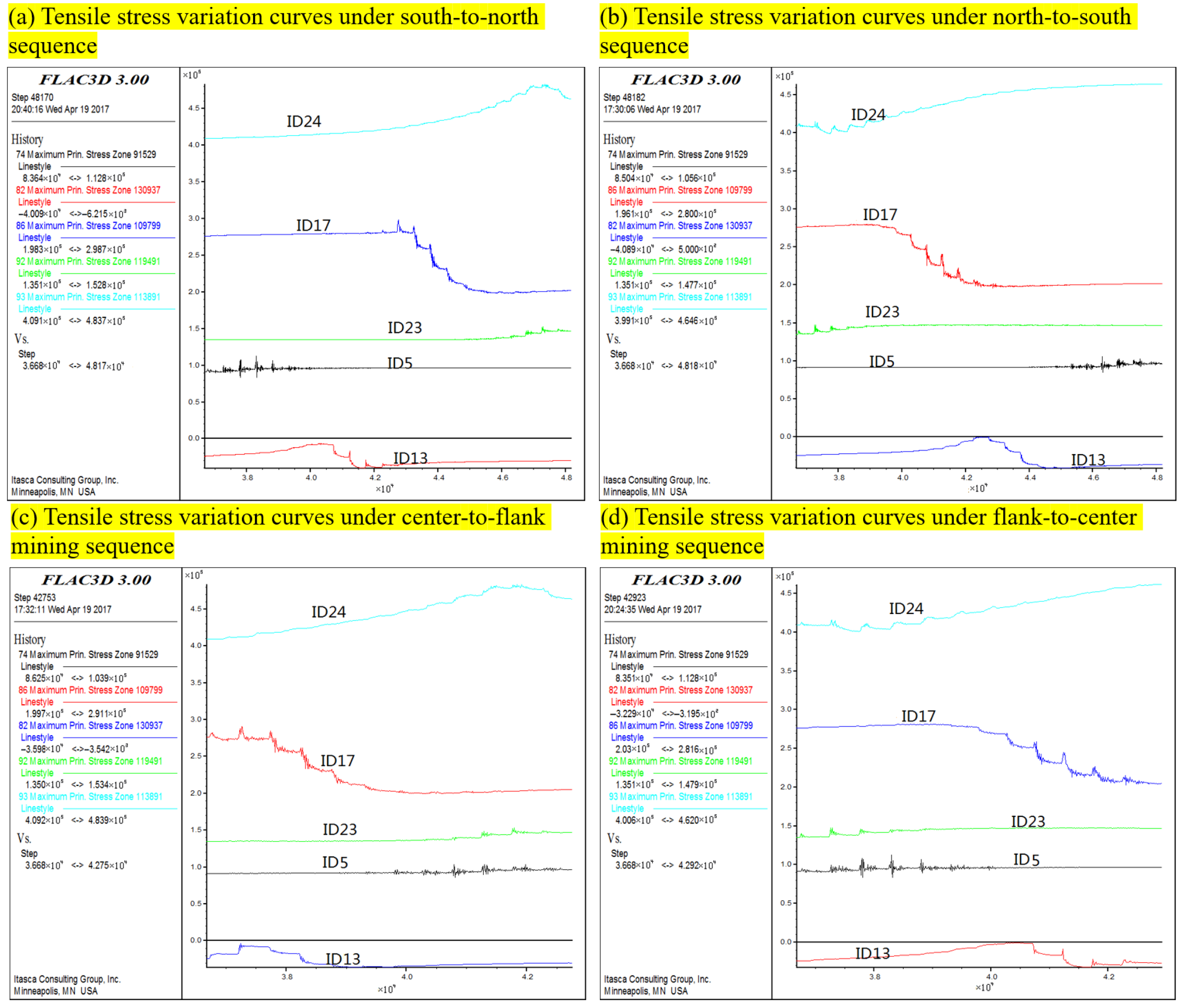

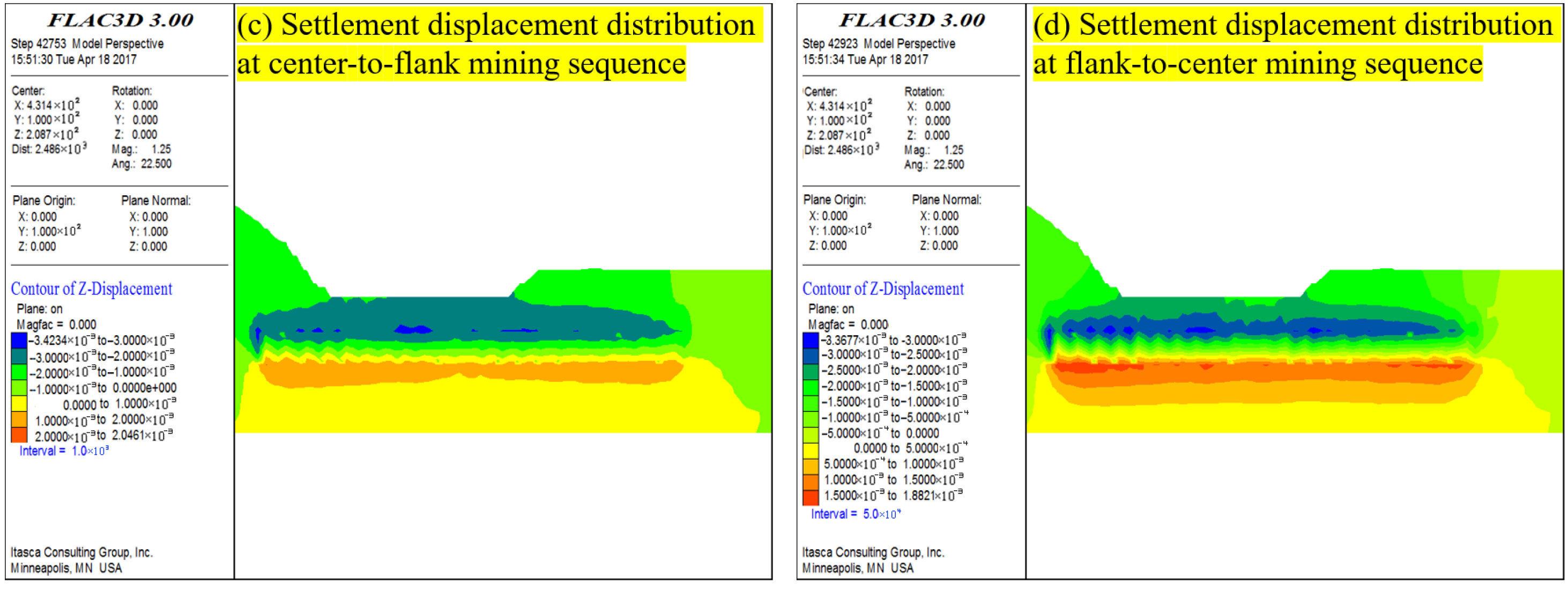
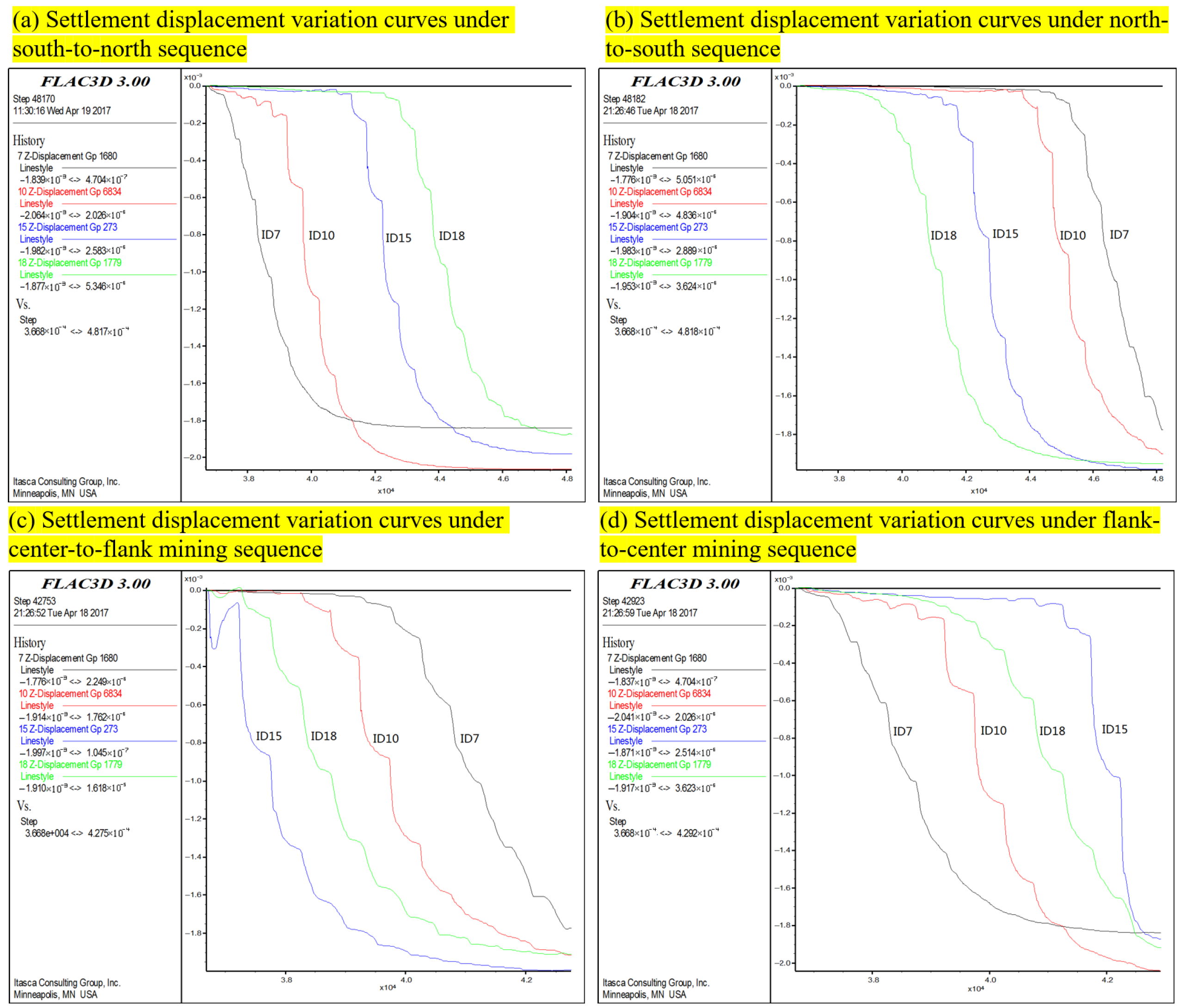
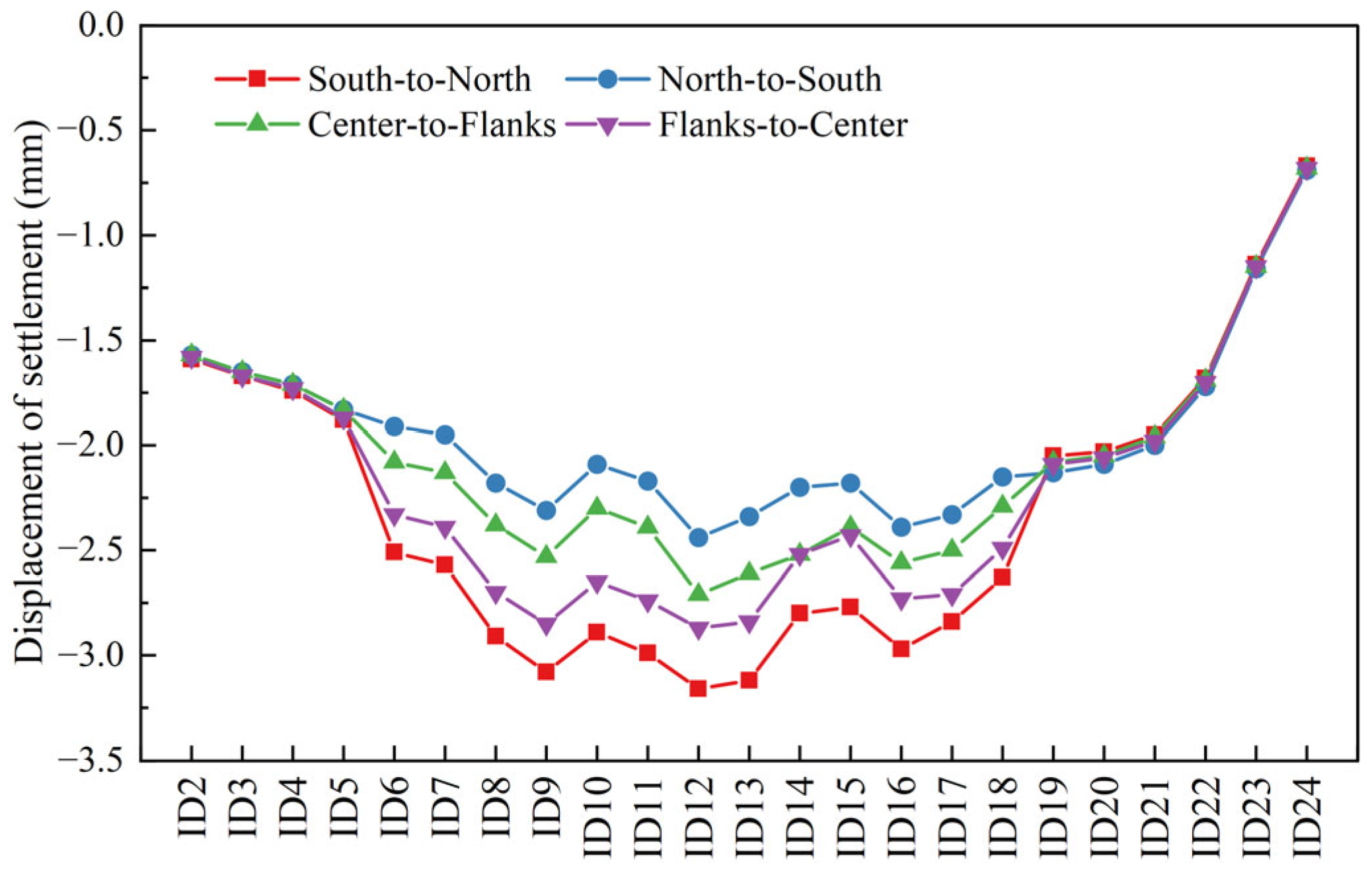
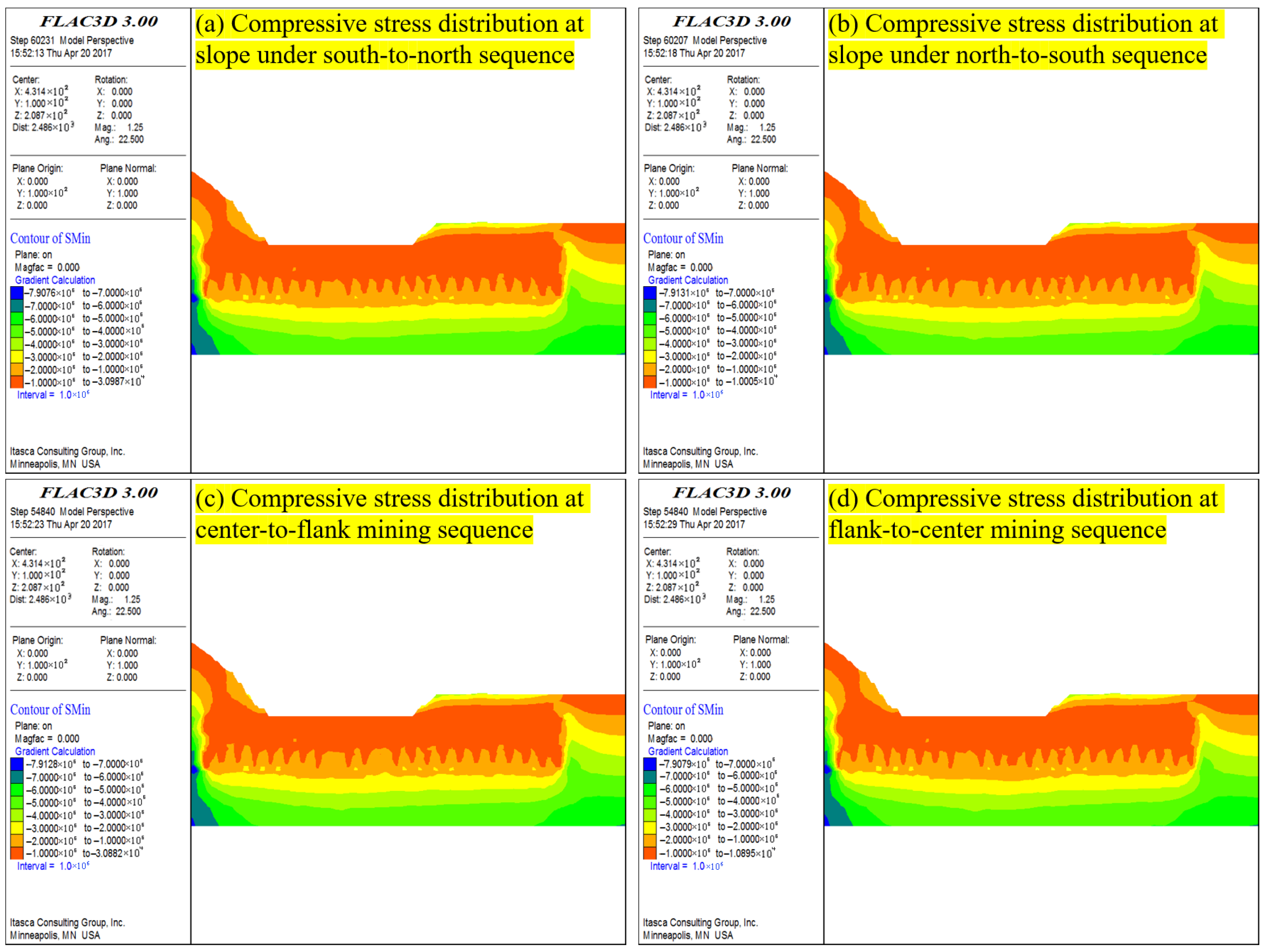

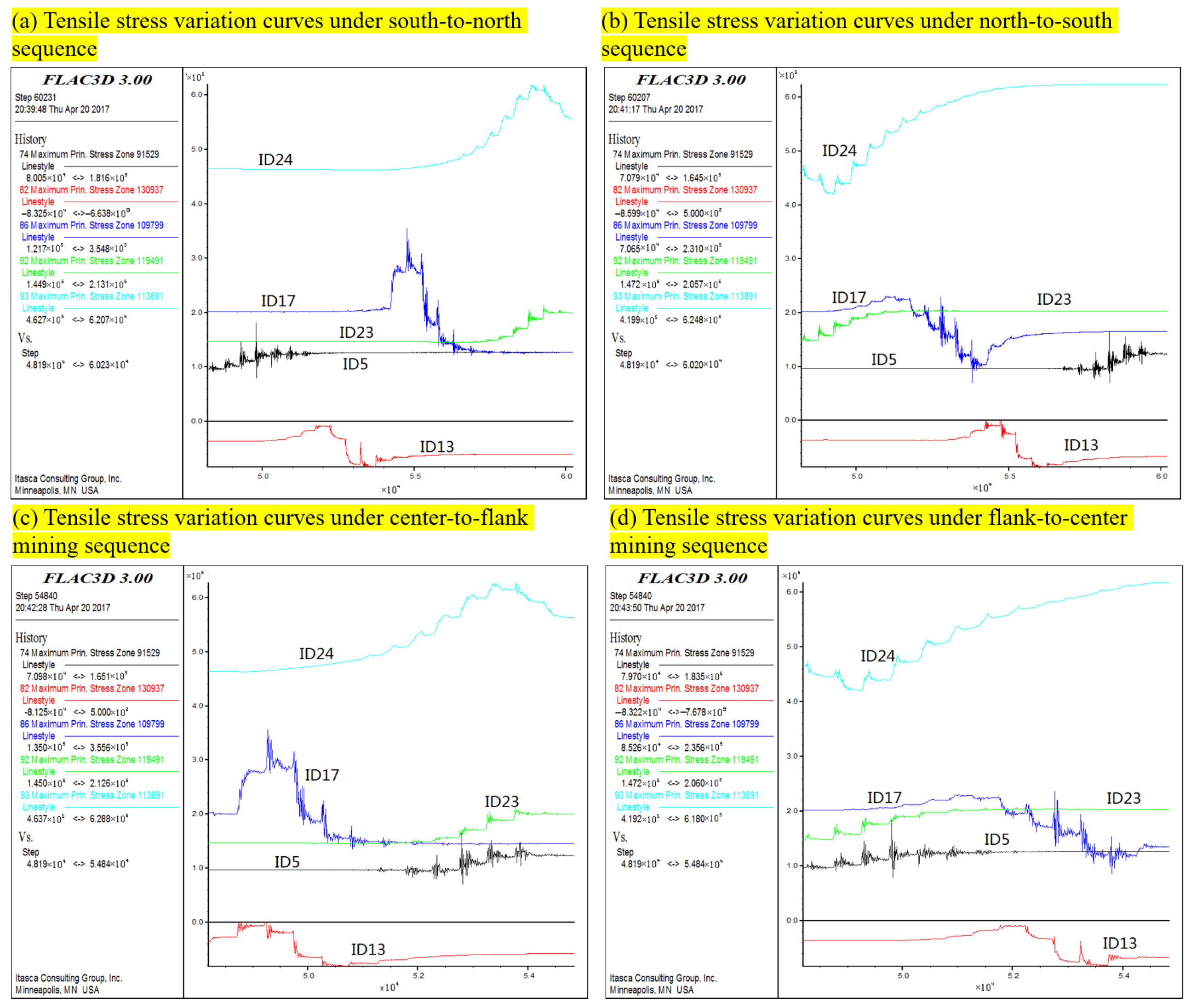


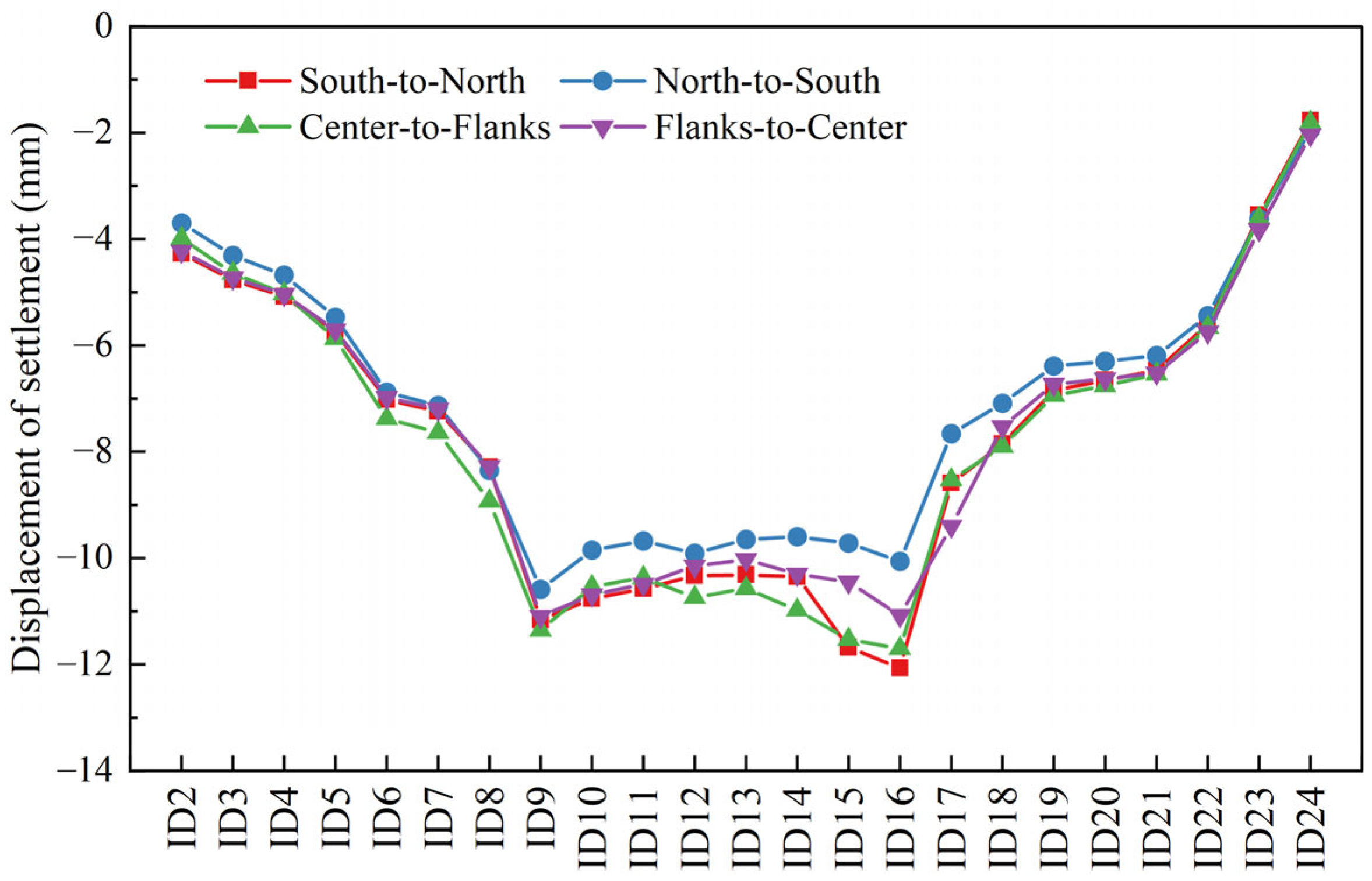
| Lithology | ρ (kg/m3) | UCS (MPa) | σt (MPa) | E (GPa) | ν (MPa) | c (MPa) | φ (°) | K (GPa) | G (GPa) |
|---|---|---|---|---|---|---|---|---|---|
| Limestone | 2697 | 33.66 | 1.51 | 12.65 | 0.24 | 5.51 | 39.34 | 8.11 | 5.10 |
| Migmatite | 2680 | 29.25 | 1.77 | 16.99 | 0.25 | 6.78 | 49.77 | 11.33 | 6.80 |
| Ore | 3131 | 20.97 | 1.22 | 11.88 | 0.26 | 4.3 | 47.19 | 8.29 | 4.71 |
| Consolidated backfill | 2210 | 3 | 0.5 | 5 | 0.23 | 0.65 | 36.0 | 3.09 | 2.03 |
| Unconsolidated backfill | 2000 | 0.5 | 0.02 | 2.5 | 0.29 | 0.10 | 30.0 | 1.98 | 0.97 |
| Monitoring Point | South-to-North | North-to-South | Center-to-Flank | Flank-to-Center |
|---|---|---|---|---|
| ID3 | 0.155 | 0.146 | 0.169 | 0.163 |
| ID5 | 0.129 | 0.117 | 0.135 | 0.136 |
| ID17 | 0.341 | 0.308 | 0.378 | 0.338 |
| ID22 | 0.152 | 0.143 | 0.173 | 0.155 |
| ID23 | 0.174 | 0.163 | 0.199 | 0.178 |
| ID24 | 0.552 | 0.512 | 0.629 | 0.554 |
| Summation | 1.503 | 1.388 | 1.684 | 1.524 |
| Monitoring Point | South-to-North | North-to-South | Center-to-Flank | Flank-to-Center |
|---|---|---|---|---|
| ID2 | −1.59 | −1.57 | −1.57 | −1.58 |
| ID3 | −1.67 | −1.65 | −1.65 | −1.67 |
| ID4 | −1.74 | −1.71 | −1.71 | −1.73 |
| ID5 | −1.88 | −1.83 | −1.83 | −1.87 |
| ID6 | −2.51 | −1.91 | −2.08 | −2.33 |
| ID7 | −2.57 | −1.95 | −2.13 | −2.39 |
| ID8 | −2.91 | −2.18 | −2.38 | −2.70 |
| ID9 | −3.08 | −2.31 | −2.53 | −2.85 |
| ID10 | −2.89 | −2.09 | −2.30 | −2.65 |
| ID11 | −2.99 | −2.17 | −2.39 | −2.74 |
| ID12 | −3.16 | −2.44 | −2.71 | −2.87 |
| ID13 | −3.12 | −2.34 | −2.61 | −2.84 |
| ID14 | −2.80 | −2.20 | −2.52 | −2.52 |
| ID15 | −2.77 | −2.18 | −2.39 | −2.43 |
| ID16 | −2.97 | −2.39 | −2.56 | −2.73 |
| ID17 | −2.84 | −2.33 | −2.50 | −2.71 |
| ID18 | −2.63 | −2.15 | −2.29 | −2.49 |
| ID19 | −2.05 | −2.13 | −2.08 | −2.09 |
| ID20 | −2.03 | −2.09 | −2.05 | −2.06 |
| ID21 | −1.95 | −2.00 | −1.96 | −1.98 |
| ID22 | −1.68 | −1.72 | −1.69 | −1.70 |
| ID23 | −1.14 | −1.16 | −1.15 | −1.15 |
| ID24 | −0.67 | −0.69 | −0.68 | −0.68 |
| Summation | −53.65 | −45.22 | −47.75 | −50.75 |
| Monitoring Point | South-to-North | North-to-South | Center-to-Flank | Flank-to-Center |
|---|---|---|---|---|
| ID3 | 0.154 | 0.146 | 0.154 | 0.158 |
| ID5 | 0.207 | 0.182 | 0.215 | 0.221 |
| ID17 | 0.405 | 0.254 | 0.463 | 0.283 |
| ID22 | 0.104 | 0.072 | 0.116 | 0.078 |
| ID23 | 0.243 | 0.227 | 0.277 | 0.247 |
| ID24 | 0.708 | 0.688 | 0.818 | 0.742 |
| Summation | 1.721 | 1.467 | 1.942 | 1.629 |
| Monitoring Point | South-to-North | North-to-South | Center-to-Flank | Flank-to-Center |
|---|---|---|---|---|
| ID2 | −4.27 | −3.70 | −3.99 | −4.23 |
| ID3 | −4.77 | −4.31 | −4.64 | −4.73 |
| ID4 | −5.08 | −4.68 | −5.03 | −5.04 |
| ID5 | −5.75 | −5.47 | −5.87 | −5.71 |
| ID6 | −7.02 | −6.88 | −7.38 | −6.98 |
| ID7 | −7.24 | −7.13 | −7.64 | −7.20 |
| ID8 | −8.29 | −8.35 | −8.93 | −8.28 |
| ID9 | −11.17 | −10.59 | −11.36 | −11.10 |
| ID10 | −10.76 | −9.85 | −10.54 | −10.69 |
| ID11 | −10.58 | −9.68 | −10.37 | −10.49 |
| ID12 | −10.33 | −9.91 | −10.74 | −10.15 |
| ID13 | −10.32 | −9.65 | −10.57 | −10.03 |
| ID14 | −10.35 | −9.60 | −10.98 | −10.30 |
| ID15 | −11.68 | −9.72 | −11.53 | −10.45 |
| ID16 | −12.07 | −10.06 | −11.70 | −11.08 |
| ID17 | −8.59 | −7.66 | −8.53 | −9.40 |
| ID18 | −7.85 | −7.09 | −7.90 | −7.53 |
| ID19 | −6.85 | −6.39 | −6.94 | −6.73 |
| ID20 | −6.66 | −6.30 | −6.76 | −6.63 |
| ID21 | −6.47 | −6.19 | −6.54 | −6.52 |
| ID22 | −5.60 | −5.44 | −5.66 | −5.75 |
| ID23 | −3.55 | −3.62 | −3.61 | −3.82 |
| ID24 | −1.78 | −1.94 | −1.81 | −2.04 |
| Summation | −177.03 | −164.22 | −179.02 | −174.89 |
Disclaimer/Publisher’s Note: The statements, opinions and data contained in all publications are solely those of the individual author(s) and contributor(s) and not of MDPI and/or the editor(s). MDPI and/or the editor(s) disclaim responsibility for any injury to people or property resulting from any ideas, methods, instructions or products referred to in the content. |
© 2025 by the authors. Licensee MDPI, Basel, Switzerland. This article is an open access article distributed under the terms and conditions of the Creative Commons Attribution (CC BY) license (https://creativecommons.org/licenses/by/4.0/).
Share and Cite
Wang, Y.; Jin, A. Research on Optimization of Orebody Mining Sequence Under Isolation Layer of Filling Body Based on FLAC3D Software. Processes 2025, 13, 2296. https://doi.org/10.3390/pr13072296
Wang Y, Jin A. Research on Optimization of Orebody Mining Sequence Under Isolation Layer of Filling Body Based on FLAC3D Software. Processes. 2025; 13(7):2296. https://doi.org/10.3390/pr13072296
Chicago/Turabian StyleWang, Yu, and Aibing Jin. 2025. "Research on Optimization of Orebody Mining Sequence Under Isolation Layer of Filling Body Based on FLAC3D Software" Processes 13, no. 7: 2296. https://doi.org/10.3390/pr13072296
APA StyleWang, Y., & Jin, A. (2025). Research on Optimization of Orebody Mining Sequence Under Isolation Layer of Filling Body Based on FLAC3D Software. Processes, 13(7), 2296. https://doi.org/10.3390/pr13072296





